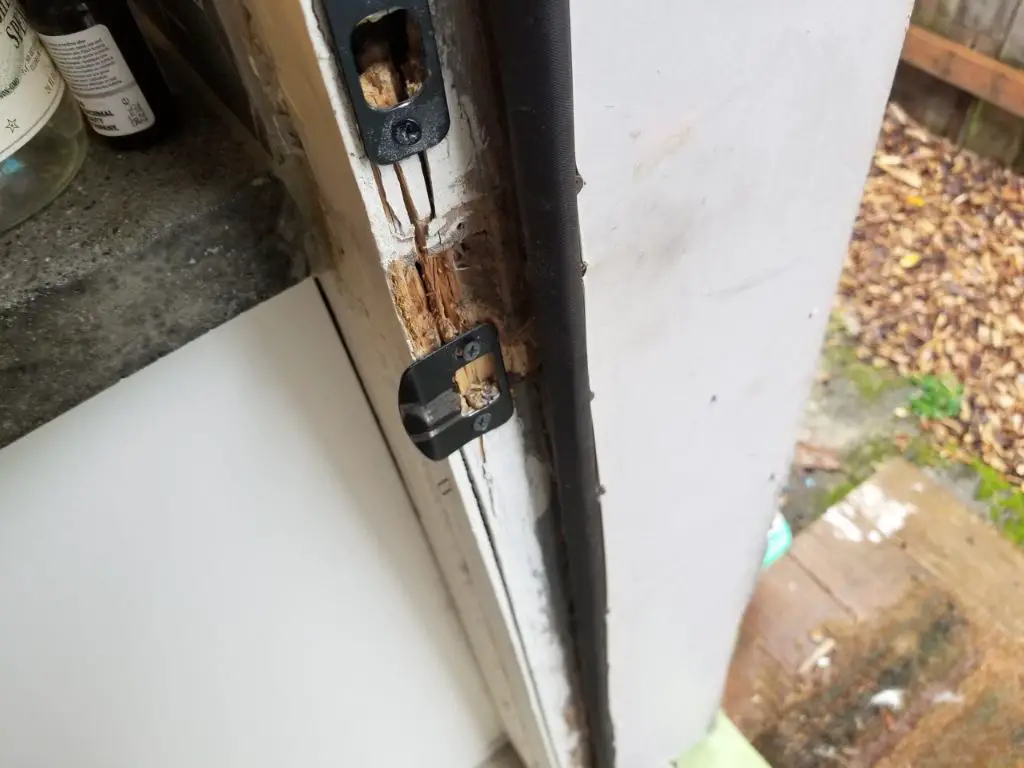A misaligned door strike plate is a common issue that can prevent your door from closing or latching properly. Fixing it is usually a straightforward DIY project that can be completed in less than an hour with some basic tools and supplies. This article provides step-by-step instructions for realigning a misaligned strike plate so your door operates smoothly again.
Page Contents
What Causes a Misaligned Strike Plate?
There are a few common reasons why a strike plate may become misaligned over time:
- The frame can shift due to settling of the house or expansion/contraction.
- Hinge screws may have loosened allowing the door to sag.
- Previous improper installation where the strike plate was not centered or aligned.
- Repeated slamming or forced closing of the door strains the jamb and frame.
The slight misalignment prevents the latch bolt from properly engaging the strike plate aperture to pull the door closed. This results in a door that doesn’t latch completely, sticks when opening/closing, or exhibits other problems. Realigning the strike plate solves these issues.
Prepare Door and Strike Plate Area
Before making any adjustments, you’ll want to do a little prep work:
- Remove any obstructions like doorstops on the jamb.
- Close the door and see how much of a gap there is. Use pennies, business cards, or index cards to slide between the jamb and door and determine the misalignment.
- Loosen any screws on the strike plate, but do not remove them yet.
This will allow you to move the strike plate more easily when adjusting.
Adjust Strike Plate Vertically
If the strike plate and bolt are misaligned vertically when closed, follow these steps:
- Insert shims or cardboard spacers above or below the strike plate to raise or lower it into alignment with the bolt.
- With the shims in place, tighten the screws to hold the strike plate in the aligned position.
- Open and close the door to test for smooth operation and proper latching.
- Remove shims and any obstructing door stops.
Be sure the strike plate aperture and bolt match up vertically when closed. Make small incremental adjustments until you achieve a correct alignment.
Adjust Strike Plate Horizontally
For horizontal alignment issues follow this process:
- Loosen the strike plate screws completely but leave them in the holes.
- Place shims or cardboard behind the strike plate to move it outward.
- Shift the strike plate left or right until the aperture aligns with the bolt.
- Secure the screws while keeping shims in place.
- Test operation of door and make additional adjustments if needed.
- Carefully remove shims.
You may need to move the strike plate side-to-side for proper horizontal alignment. Take your time and make small, incremental adjustments.
Add Reinforcements for Extra Support
For strike plates that are loose due to enlarged screw holes, door jambs that feel unstable, or other issues, consider adding reinforcements:
- Longer screws – Replace existing screws with 3-4 in. screws that reach framing studs for more holding power.
- Wood glue – Coat toothpicks or wood matchsticks with wood glue and insert into enlarged screw holes. Trim flush after drying.
- Strike plate supports – Install metal strike plate supports or metal shims behind plate for more stability.
- Extra strike plate – Layer a second strike plate directly over the existing plate and screw into place.
Reinforcements help prevent future loosening by providing extra strength and stability.
Fill and Repaint Strike Plate
Once the strike plate is properly aligned, complete the job by:
- Filling any remaining gaps around the strike plate with wood filler, caulk, or wood putty.
- Allow the filler to dry completely.
- Sand smooth and repaint to match the door jamb.
This provides a nice finished look and further stabilizes the strike plate area.
Tips for Proper Strike Plate Alignment
Follow these tips for best results when adjusting your misaligned strike plate:
- Work slowly and make small adjustments to prevent over-correction.
- Use shims and spacers to temporarily hold adjustments in place.
- Check door operation frequently as you go until proper alignment is achieved.
- Use longer screws in existing holes for maximum holding power.
- Reinforce loose or damaged wood around screw holes.
- Consider installing a security strike plate for added strength.
Careful alignment and using reinforcements can help prevent future issues with the strike plate coming out of alignment.
When to Call a Professional
While minor strike plate adjustments are well within DIY capabilities, there are some instances when you may want to call a professional:
- The door frame or jamb is badly warped, split, or damaged.
- There are larger underlying issues causing the misalignment.
- You are unable to adjust the strike plate properly yourself.
- There are concerns about security or lock function.
- You want to upgrade to a high-security strike plate system.
A carpenter can repair underlying damage, while a locksmith can install heavy-duty strike plates and high-security locks. The costs of professional repairs will depend on the specifics of your situation.
Conclusion
Adjusting a misaligned door strike plate is usually a quick and easy DIY project. In most cases, you can realign the strike plate vertically and horizontally as needed using shims and basic tools. Longer screws, reinforcements, wood filler, and matching paint provide extra strength and a professional-looking finish. Pay attention to proper alignment, work slowly, and make adjustments in small increments. In severe cases with underlying structural issues, consider calling a professional for repairs.
